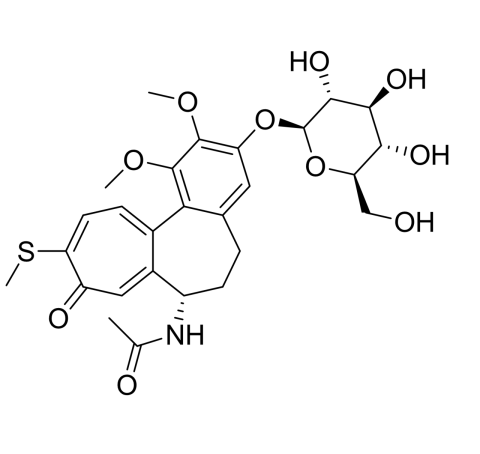Thiocolchicoside is a muscle relaxant and anti-inflammatory medication that has been used clinically for more than 35 years. It is a semi-synthetic derivative of colchicoside, a natural compound obtained from the seeds of the Gloriosa superba plant. Its therapeutic effects are attributed to its active metabolite, a 3-O-glucuronidated aglycone, which functions as a selective GABA-A receptor antagonist. This effect helps relieve painful muscle spasms linked to conditions like low back pain and musculoskeletal injuries.
BRAND NAMES
Muscoril, Myoril, Mobiwok, Thioquest and Neoflax.
Thiocolchicoside can be taken by mouth in the form of tablets or capsules. In some cases, it may be administered as an injection into a muscle.
MECHANISM OF ACTION
Thiocolchicoside primarily acts as a muscle relaxant by targeting the central nervous system, where it modulates neurotransmitter activity to reduce muscle spasms. Its mechanism is believed to involve both GABAergic and glycinergic pathways, although it remains complex and not fully understood. The drug binds to GABA-A and glycine receptors—key components in regulating muscle tone and inhibiting pain transmission—resulting in muscle relaxation and pain relief.
PHARMACOKINETICS
Absorption
Thiocolchicoside has low oral absorption and is rapidly metabolized, which impacts its bioavailability depending on the method of administration. After oral intake, the parent drug is not detectable in the bloodstream; its therapeutic effects are instead attributed to its active metabolites.
Distribution
Following an intramuscular dose of 8 mg, the apparent volume of distribution of thiocolchicoside is estimated to be approximately 42.7 liters.
Metabolism
Thiocolchicoside is extensively metabolized into several compounds, primarily through intestinal and hepatic metabolism. The metabolic pathway and resulting active metabolites differ significantly depending on the route of administration, particularly when comparing oral versus intramuscular (IM) use.
Excretion
Following oral administration, the majority of the total radioactivity is excreted in the feces approximately 79%, while urinary excretion accounts for about 20%.
PHARMACODYNAMICS
Thiocolchicoside’s pharmacodynamics involve central action primarily through potentiation of GABA-A receptors, helping to inhibit muscle spasms and promote muscle relaxation. It also binds to glycine receptors, further contributing to its muscle-relaxing effects. In addition, it demonstrates anti-inflammatory effects by decreasing the production of pro-inflammatory cytokines. This dual mechanism results in effective muscle relaxation, pain relief, and reduction of inflammation associated with painful muscle contractures.
ADMINISTRATION
Thiocolchicoside is a muscle relaxant with anti-inflammatory properties, indicated for the short-term treatment of painful muscle spasms in adults and adolescents aged 16 years and older. It is available in oral and injectable forms, and should be taken only as prescribed by a doctor.
DOSAGE AND STRENGTH
Thiocolchicoside is available in several dosage forms, including oral, intramuscular, and topical preparations. Thiocolchicoside oral capsules and intramuscular injections are available in different strengths.
DRUG INTERACTIONS
Thiocolchicoside primarily interacts with other central nervous system (CNS) depressants, such as alcohol, other muscle relaxants, and sedatives, which can intensify drowsiness and impair coordination. Caution is also advised when combining it with blood thinners like warfarin, as it may increase the risk of bleeding. Additionally, taking it with NSAIDs, such as diclofenac, can heighten the risk of gastrointestinal bleeding.
FOOD INTERACTIONS
Taking thiocolchicoside with food helps reduce potential gastrointestinal upset, though no foods are known to significantly alter its effects. However, you must avoid alcohol due to the risk of increased side effects.
CONTRAINDICATIONS
Thiocolchicoside is contraindicated in people with a known allergy to the drug, women who are pregnant or breastfeeding, and people with a history of seizures. The drug also carries a risk of genotoxicity, which can impair male fertility.
SIDE EFFECTS
Drowsiness, sleepiness, or dizziness.
Gastrointestinal issues: Nausea, vomiting, diarrhea, stomach pain, gas, or heartburn.
Dry mouth.
Headache.
Allergic reactions.
Liver problems.
Neurological issues.
Fertility problems.
OVER DOSE
An overdose can amplify the drug's typical side effects and cause more severe symptoms. These may include:
Excessive drowsiness and sleepiness.
Gastrointestinal side effects may include nausea, vomiting, abdominal pain, and diarrhea.
Central nervous system effects, including confusion, agitation, or seizures.
Neurological symptoms, which can include disorientation.
Muscle weakness.
TOXICITY
Thiocolchicoside carries significant toxicity risks, primarily linked to its metabolite, 3-demethylthiocolchicine (M2), which has been shown to induce damage to dividing cells. As a result, the use of thiocolchicoside is heavily restricted in many regions and should always be limited to the lowest effective dose for the shortest possible duration.







